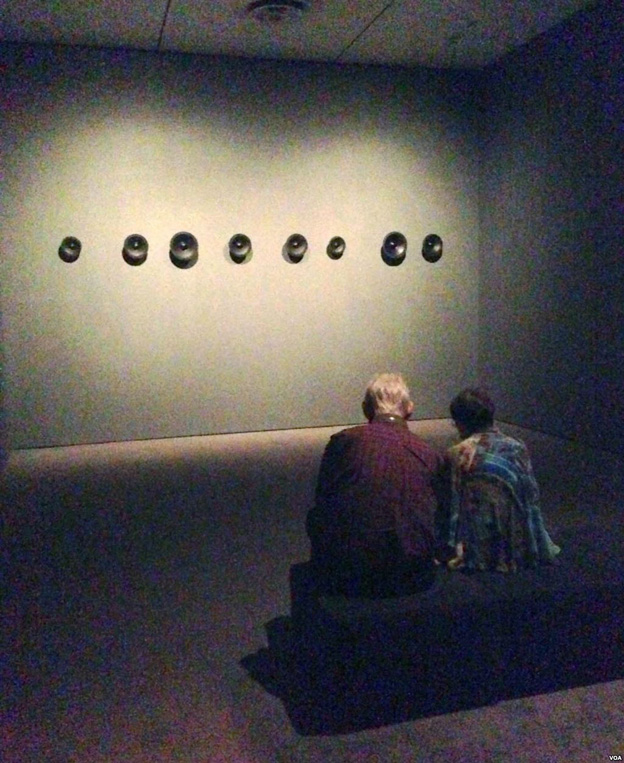by Adam Phillips
August 16, 2013
From: http://www.voanews.com/content/audio-art-sounds-off-at-nyc-modern-art-museum/1731088.html
NEW YORK — Art is thought of as a visual medium, but sound is the focus of anew show at the Museum of Modern Art (MoMA) in New York City.
MoMA presents an auditory landscape with anexhibit called "Soundings, a Contemporary Score."
“Themuseum-goer walks into a space, and because they are in MoMA, they know theyare going to see something traditional, like Picasso," said curatorBarbara London. "But they are going to see something very unconventionaland maybe surprising. Maybe they’re baffled.”
Many museum-goers are baffled, then amusedby Richard Garet’s “Before Me” installation, which amplifies the sound of aglass marble spinning on the metal casing of a phonograph turntable.
Sound, video and memory combine in “MusicWhile We Work,” by Hong-Kai Wang, in which Taiwanese retirees record the soundsthey heard during their working life at a sugar refinery.
There’s a common theme among the 16 artistsrepresented here.
“I think mostof the artists in the show want you to listen or pause and listen," Londonsaid. "They’re saying, ‘Hey, slow down. There are various forms of poetryand beauty in the world.’”
It is the world the unaided human earcannot hear that animates Norwegian artist Jana Winderen’s sound montage,“Ultrafield.”
Winderen used echolocation devices tocapture the ultrasonic radar made by bats, and tiny ultra-sensitive underwatermicrophones to record the movements of sea beetles less than two millimeterslong. She wants to draw attention to endangered ecosystems in the earth’shidden worlds, and give the listener a chance to experience their magic.
“It'sinstalled in a dark space," Winderen said. "And I am actually hopingpeople can slow down and enjoy also the listening experience itself, notnecessarily thinking about what it is, or what kind of a message I have withit.”
Some sounds are hiding in plain sight, butwe don’t have the subtlety of perception to pick them out. At a distance offive meters or so, Tristan Perich’s “Microtonal Wall,” emits “white noise.”
That is a sound containing so many sounds,or pitches, that no individual one can be distinguished. Leaves rustling in thebreeze and the ocean surf are both examples of the phenomenon.
Perich has broken four octaves of themusical scale into 1,500 of the pitches that make up those octaves and giveneach pitch its own small speaker. Close up, or moving slowly past thosespeakers, one hears their differences.
"My piece, with 1,500 speakers, eachplaying individual pitches, is still just a finite fraction of this infinitesound," Perich said. "It’s just a gesture towards this idea of theinfiniteness of white noise, building it up.”
Sound that is implied, rather than heard,has made some of the loudest buzz at the MoMA show. Camille Norment’s work“Triplight,” consists mostly of a stand-up steel ribbed microphone, circa 1955,used by performers like Billie Holiday and Louis Armstrong. Inside the mic, shehas placed a bright flickering light.
“One thing Iwanted to do was to play with the idea of inability of articulation, thestuttering voice perhaps, this desire to express oneself and the struggle itoften entails," Norment said. "And the light casts a shadow that isreminiscent of vertebrae and ribs, or a ribcage or a mask. So the piece, in away, reenacts the presence of the body that is no longer present.”
?Susan Philipsz' “Study for Strings,” isthe most heart-wrenching piece in the show. It’s based on a 1943 orchestralwork Czech composer Pavel Haas wrote while in a German concentration camp.
Soon after performing the work for a Nazipropaganda film, Haas and his orchestra members were killed. The musicians inPhilipsz’ artwork play only two of the parts in the score, emphasizing theabsence of the other players.
It’s just one of the pieces in the Museum of Modern Art's “Soundings” show thathighlight the dance between silence and sound.

 Pay attention to us
×
Pay attention to us
×